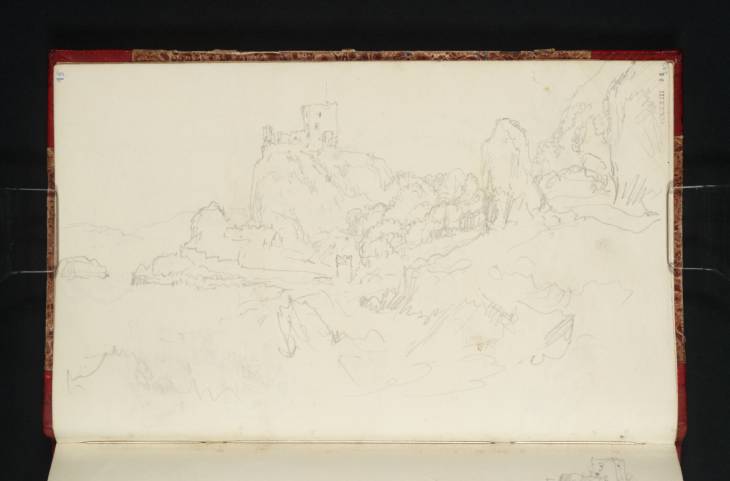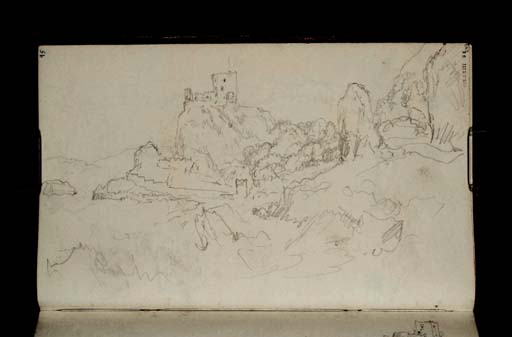J.M.W. Turner
>
1830-35 Annual tourist
>
Scotland 1831
>
Staffa Sketchbook
>
Artwork
Joseph Mallord William Turner Dunollie Castle 1831
Image 1 of 2
Joseph Mallord William Turner,
Dunollie Castle
1831
Joseph Mallord William Turner 1775–1851
Folio 95 Recto:
Dunollie Castle 1831
D26928
Turner Bequest CCLXXIII 95
Turner Bequest CCLXXIII 95
Pencil on white wove paper, 116 x 186 mm
Inscribed in blue ink by John Ruskin ‘95’ top left running vertically, and ‘293’ top right running vertically
Stamped in black ‘CCLXXIII 95’ top right running vertically
Inscribed in blue ink by John Ruskin ‘95’ top left running vertically, and ‘293’ top right running vertically
Stamped in black ‘CCLXXIII 95’ top right running vertically
Accepted by the nation as part of the Turner Bequest 1856
References
1909
A.J. Finberg, A Complete Inventory of the Drawings of the Turner Bequest, London 1909, vol.II, p.878, CCLXXIII 95, as ‘Dunolly Castle.’.
1991
David Wallace-Hadrill and Janet Carolan, ‘Turner in Argyll in 1831: Inveraray to Oban’, Turner Studies, vol. 11, no.1, Summer 1991, pp.25, 29.
Although Turner had not been commissioned to paint Dunollie Castle, and made nothing of his sketches, the subject did hold enough interest for him to make about a dozen sketches of it, although sometimes only as a background element. Part of his interest was presumably the picturesque potential of ruins perched on a cliff above water; a feature also of the nearby Dunstaffnage Castle, e.g. folio 89 verso (D26917). In this sense he was in agreement with Sir Walter Scott who wrote in a note to his poem Lord of the Isles: ‘nothing can be more wildly beautiful than the situation of Dunolly’.1 It may have been this comment, or a conversation with the author when Turner met him at Abbotsford about three weeks earlier (see Abbotsford sketchbook, Tate D25929–D26095; D40995–D40996; Turner Bequest CCLXVII complete sketchbook) that inspired the artist’s interest.
The present sketch and two further sketches on folios 94 verso and 95 verso (D26927, D26929) were made from near the castle to the east. Turner may have made these on his way to the town of Oban from Loch Etive, or on a short excursion from the town, which lies just a mile away to the south. Two sketches of Oban Bay may also have been made at the castle: folios 93 verso and 96 (D26925, D26930).
Turner included the ruin of Dunollie in two lively drawings made at Oban: folios 58 and 59 (D26854, D26856); in sketches from the east of the town around Pulpit Hill: folios 79 verso (D26897) and 98 verso (D26933; CCLXXIII 97a); from the Gallanach Road to the south: folios 59 verso, 60 and 60 verso (D26857, D26858, D26859); and from south of Gallanach: folios 78 and 78 verso (D26894, D26895). He also sketched the castle from Kerrera and the Sound of Kerrera to the west: folios 61 and 96 verso (D26860, D26931), and on his return to Oban from his visits to the Western Isles: folios 56 verso and 57 (D26851, D26852).
The present drawing is the artist’s most finished depiction of the castle, and is the view chosen most often by artists and tourists alike.2 From the beach to the south-east of the castle, where the road now runs to Oban, this sketch looks north along the beach to the ruins which are perched on the edge of a cliff above the water. The ruins consist of a three-storey keep with walls projecting from the southern corner and the north-east side, both presumably fragments of connected buildings. There appears to be a flagpole at the top of the keep, although the MacDougalls, who then owned the castle, had by this time abandoned it and built Dunollie House nearby. Just up the bank at the right of the sketch is a large boulder called the Dog Stone, and beneath the cliff is the corner tower of a wall that surrounds the south and east sides of the castle.
Thomas Ardill
February 2010
How to cite
Thomas Ardill, ‘Dunollie Castle 1831 by Joseph Mallord William Turner’, catalogue entry, February 2010, in David Blayney Brown (ed.), J.M.W. Turner: Sketchbooks, Drawings and Watercolours, Tate Research Publication, December 2012, https://www


